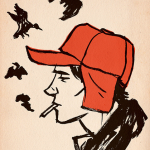I think I know why people may want to be a model.
The veneer of being extraordinarily beautiful, garnering loads of attention, making oodles of money, being showered with free clothes, and rubbing elbows with fashion big shots sounds appealing.
And they’re partly right. Being a successful high fashion model brings with it a jet set lifestyle of glamour. So what’s the problem?
The recently concluded Fall-Winter 2013 collections at New York Fashion Week (NYFW) continues to perpetuate the myth that white skin is something to aspire to. For example, although our latest census puts the Hispanic or Latino population at 16.7%, only 2% of NYFW’s models were Hispanic or Latino. If fashion wants a glimpse into the future consequences of ignoring this growing segment of our population, it should take a good, hard look at the Republican party.
High fashion is aspirational. The looks that stomp down the runway are very rarely replicated in real-life because most of them are unattainable and impractical. They serve as an idea – the mink-lined leather sandals at Celine? Maybe they’ll revive Birkenstocks this summer. The tweed briefs worn bare-legged at Marc Jacobs? Maybe next fall will extend the current winter shorts over tights look. So, if high fashion is aspirational, what does this teach us about the models who wear the runway looks? We may not be tall, thin, and white; but we should try as hard as we can to look tall, thin, and white.
While fashion continues to perpetuate a near mythical and racist beauty standard, perhaps the most destructive facet of high fashion modeling is the use of child models. In 2012, the influential Council of Fashion Designers of America (CFDA) issued guidelines encouraging designers to only use models 16 years and up. However, many designers have ignored this very lenient guideline.
The narrow hips, small breasts, and stick-thin body frame continues to be chic. And who has this body type? Mostly teenage girls – 13, 14, 15 year olds. As a result of the designers’ vanity, these young girls are subjected to withering scrutiny about their looks during their most vulnerable and formative years and manipulated into sexually suggestive poses and clothing. Some of fashion’s top photographers, most notably Terry Richardson, are notorious womanizers who often coerce models into sexual favors in return for work.
Yet, fashion doesn’t blink an eye at sending child models into this very dark and adult world.
So why would anyone want to be a model in a racist industry that exploits children? In its current state, I don’t know. But there’s hope. My hope is that Christians will take an interest in fashion, become players in the industry, and refuse to allow the current treatment of models to continue.















